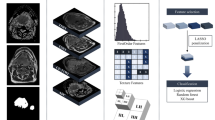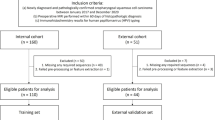Abstract
Purpose
To evaluate the correlation between histogram parameters derived from pseudo-continuous arterial spin labeling (PCASL) and human papillomavirus (HPV) status in patients with oropharyngeal squamous cell carcinoma (OPSCC).
Methods
This study included a total of 58 patients (HPV-positive: n = 45; -negative: n = 13) from a prospective cohort of consecutive patients aged ≥ 18 years, who were newly diagnosed with oropharyngeal squamous cell carcinoma. All patients were required to have undergone pre-treatment MRI with PCASL to measure regional perfusion. The region of interest was drawn by two radiologists, encompassing the entire tumor volume on all corresponding slices. Differences in the histogram parameters derived from tumor blood flow (TBF) in ASL were assessed for HPV-positive and -negative patients. Receiver operating characteristic curve analysis was performed to determine the best differentiating parameters, and a leave-one-out cross-validation was used.
Results
Patients with HPV-positive OPSCC showed a significantly lower overall standard deviation and 95th percentile value of tumor blood flow (P < .007). The standard deviation of TBF was the single best predictive parameter. Leave-one-out cross-validation tests revealed that the area under the receiver operating characteristic curve, accuracy, sensitivity, and specificity were 0.745, 75.9%, 75.6%, and 76.9%, respectively.
Conclusion
PCASL revealed differences in perfusion parameters according to HPV status in patients with OPSCC, reflecting their distinct histopathology.


Similar content being viewed by others
Abbreviations
- ASL:
-
Arterial spin labeling
- EGFR:
-
Epidermal growth factor receptor
- HPV:
-
Human papillomavirus
- OPSCC:
-
Oropharyngeal squamous cell carcinoma
- PCASL:
-
Pseudo-continuous arterial spin labeling
- ROC:
-
Receiver operating characteristic
- SD:
-
Standard deviation
- CV:
-
Coefficient of variance
- TBF:
-
Tumor blood flow
References
Amin MB, Greene FL, Edge SB, Compton CC, Gershenwald JE, Brookland RK et al (2017) The Eighth Edition AJCC Cancer Staging Manual: continuing to build a bridge from a population-based to a more “personalized” approach to cancer staging. CA Cancer J Clin 67(2):93–99. https://doi.org/10.3322/caac.21388
Amin MB, Edge SB (2017) AJCC cancer staging manual. Springer
Troy JD, Weissfeld JL, Youk AO, Thomas S, Wang L, Grandis JR (2013) Expression of EGFR, VEGF, and NOTCH1 suggest differences in tumor angiogenesis in HPV-positive and HPV-negative head and neck squamous cell carcinoma. Head Neck Pathol 7(4):344–55. https://doi.org/10.1007/s12105-013-0447-y
Mungai F, Verrone GB, Pietragalla M, Berti V, Addeo G, Desideri I et al (2019) CT assessment of tumor heterogeneity and the potential for the prediction of human papillomavirus status in oropharyngeal squamous cell carcinoma. Radiol Med 124(9):804–11. https://doi.org/10.1007/s11547-019-01028-6
Bos P, van den Brekel MWM, Gouw ZAR, Al-Mamgani A, Waktola S, Aerts HJWL et al (2021) Clinical variables and magnetic resonance imaging-based radiomics predict human papillomavirus status of oropharyngeal cancer. Head & Neck 43(2):485–95. https://doi.org/10.1002/hed.26505
Ravanelli M, Grammatica A, Tononcelli E, Morello R, Leali M, Battocchio S et al (2018) Correlation between human papillomavirus status and quantitative MR imaging parameters including diffusion-weighted imaging and texture features in oropharyngeal carcinoma. AJNR Am J Neuroradiol 39(10):1878–83. https://doi.org/10.3174/ajnr.A5792
de Perrot T, Lenoir V, Domingo Ayllon M, Dulguerov N, Pusztaszeri M, Becker M (2017) Apparent diffusion coefficient histograms of human papillomavirus-positive and human papillomavirus-negative head and neck squamous cell carcinoma: assessment of tumor heterogeneity and comparison with histopathology. AJNR Am J Neuroradiol 38(11):2153–60. https://doi.org/10.3174/ajnr.A5370
Meyer HJ, Leifels L, Hamerla G, Hohn AK, Surov A (2019) Associations between histogram analysis parameters derived from DCE-MRI and histopathological features including expression of EGFR, p16, VEGF, Hif1-alpha, and p53 in HNSCC. Contrast Media Mol Imaging 2019:5081909. https://doi.org/10.1155/2019/5081909
Noguchi T, Yoshiura T, Hiwatashi A, Togao O, Yamashita K, Nagao E et al (2008) Perfusion imaging of brain tumors using arterial spin-labeling: correlation with histopathologic vascular density. AJNR Am J Neuroradiol 29(4):688–93. https://doi.org/10.3174/ajnr.A0903
St Lawrence KS, Frank JA, McLaughlin AC (2000) Effect of restricted water exchange on cerebral blood flow values calculated with arterial spin tagging: a theoretical investigation. Magn Reson Med 44(3):440–9. https://doi.org/10.1002/1522-2594(200009)44:3%3c440::aid-mrm15%3e3.0.co;2-6
Wong EC (2007) Vessel-encoded arterial spin-labeling using pseudocontinuous tagging. Magn Reson Med 58(6):1086–91. https://doi.org/10.1002/mrm.21293
Fujima N, Kudo K, Tsukahara A, Yoshida D, Sakashita T, Homma A et al (2015) Measurement of tumor blood flow in head and neck squamous cell carcinoma by pseudo-continuous arterial spin labeling: comparison with dynamic contrast-enhanced MRI. J Magn Reson Imaging 41(4):983–91. https://doi.org/10.1002/jmri.24885
Fujima N, Kameda H, Tsukahara A, Yoshida D, Sakashita T, Homma A et al (2015) Diagnostic value of tumor blood flow and its histogram analysis obtained with pCASL to differentiate sinonasal malignant lymphoma from squamous cell carcinoma. Eur J Radiol 84(11):2187–93
Fujima N, Kudo K, Yoshida D, Homma A, Sakashita T, Tsukahara A et al (2014) Arterial spin labeling to determine tumor viability in head and neck cancer before and after treatment. J Magn Reson Imaging 40(4):920–8. https://doi.org/10.1002/jmri.24421
Vandenbroucke JP, von Elm E, Altman DG, Gotzsche PC, Mulrow CD, Pocock SJ et al (2007) Strengthening the Reporting of Observational Studies in Epidemiology (STROBE): explanation and elaboration. Ann Intern Med 147(8):W163-94. https://doi.org/10.7326/0003-4819-147-8-200710160-00010-w1
von Elm E, Altman DG, Egger M, Pocock SJ, Gotzsche PC, Vandenbroucke JP (2007) The Strengthening the Reporting of Observational Studies in Epidemiology (STROBE) statement: guidelines for reporting observational studies. Ann Intern Med 147(8):573–7. https://doi.org/10.7326/0003-4819-147-8-200710160-00010
Choi YJ, Chung MS, Koo HJ, Park JE, Yoon HM, Park SH (2016) Does the reporting quality of diagnostic test accuracy studies, as defined by STARD 2015, affect citation? Korean J Radiol 17(5):706–14. https://doi.org/10.3348/kjr.2016.17.5.706
Fujima N, Yoshida D, Sakashita T, Homma A, Tsukahara A, Tha KK et al (2016) Usefulness of pseudocontinuous arterial spin-labeling for the assessment of patients with head and neck squamous cell carcinoma by measuring tumor blood flow in the pretreatment and early treatment period. AJNR Am J Neuroradiol 37(2):342. https://doi.org/10.3174/ajnr.A4513
King AD, Chow K-K, Yu K-H, Mo FKF, Yeung DK, Yuan J et al (2013) Head and neck squamous cell carcinoma: diagnostic performance of diffusion-weighted MR imaging for the prediction of treatment response. Radiology 266(2):531–8
Choi YJ, Lee JH, Kim HO, Kim DY, Yoon RG, Cho SH et al (2016) Histogram analysis of apparent diffusion coefficients for occult tonsil cancer in patients with cervical nodal metastasis from an unknown primary site at presentation. Radiology 278(1):146–55. https://doi.org/10.1148/radiol.2015141727
Lee S, Lee SW, Park S, Yoon SM, Park JH, Song SY et al (2017) Refining prognostic stratification of human papillomavirus-related oropharyngeal squamous cell carcinoma: different prognosis between T1 and T2. Radiat Oncol J 35(3):233–40. https://doi.org/10.3857/roj.2017.00465
DeLong ER, DeLong DM, Clarke-Pearson DL (1988) Comparing the areas under two or more correlated receiver operating characteristic curves: a nonparametric approach. Biometrics 44(3):837–45
Park SH, Goo JM, Jo C-H (2004) Receiver operating characteristic (ROC) curve: practical review for radiologists. Korean J Radiol 5(1):11–8
Koo TK, Li MY (2016) A guideline of selecting and reporting intraclass correlation coefficients for reliability research. J Chiropr Med 15(2):155–63. https://doi.org/10.1016/j.jcm.2016.02.012
Buch K, Fujita A, Li B, Kawashima Y, Qureshi MM, Sakai O (2015) Using texture analysis to determine human papillomavirus status of oropharyngeal squamous cell carcinomas on CT. AJNR Am J Neuroradiol 36(7):1343–8. https://doi.org/10.3174/ajnr.A4285
Ranjbar S, Ning S, Zwart CM, Wood CP, Weindling SM, Wu T et al (2018) Computed tomography-based texture analysis to determine human papillomavirus status of oropharyngeal squamous cell carcinoma. J Comput Assist Tomogr 42(2):299–305. https://doi.org/10.1097/rct.0000000000000682
Bogowicz M, Riesterer O, Ikenberg K, Stieb S, Moch H, Studer G et al (2017) Computed tomography radiomics predicts HPV status and local tumor control after definitive radiochemotherapy in head and neck squamous cell carcinoma. Int J Radiat Oncol Biol Phys 99(4):921–8. https://doi.org/10.1016/j.ijrobp.2017.06.002
Bossi P, Resteghini C, Paielli N, Licitra L, Pilotti S, Perrone F (2016) Prognostic and predictive value of EGFR in head and neck squamous cell carcinoma. Oncotarget 7(45):74362–79. https://doi.org/10.18632/oncotarget.11413
Yoo RE, Choi SH, Cho HR, Kim TM, Lee SH, Park CK et al (2013) Tumor blood flow from arterial spin labeling perfusion MRI: a key parameter in distinguishing high-grade gliomas from primary cerebral lymphomas, and in predicting genetic biomarkers in high-grade gliomas. J Magn Reson Imaging 38(4):852–60. https://doi.org/10.1002/jmri.24026
Prigge ES, Arbyn M, von Knebel DM, Reuschenbach M (2017) Diagnostic accuracy of p16(INK4a) immunohistochemistry in oropharyngeal squamous cell carcinomas: a systematic review and meta-analysis. Int J Cancer 140(5):1186–98. https://doi.org/10.1002/ijc.30516
Abdel Razek AAK, Nada N (2018) Arterial spin labeling perfusion-weighted MR imaging: correlation of tumor blood flow with pathological degree of tumor differentiation, clinical stage and nodal metastasis of head and neck squamous cell carcinoma. Eur Arch Otorhinolaryngol 275(5):1301–7. https://doi.org/10.1007/s00405-018-4950-3
Funding
No direct funding was received for the work presented in this manuscript.
Author information
Authors and Affiliations
Corresponding author
Ethics declarations
Ethical approval
All procedures performed in the studies involving human participants were in accordance with the ethical standards of the institutional and/or national research committee and with the 1964 Helsinki declaration and its later amendments or comparable ethical standards.
Informed consent
Informed consent was obtained from all individual participants included in the study.
Conflict of interest
We declare that we have no conflict of interest.
Additional information
Publisher's note
Springer Nature remains neutral with regard to jurisdictional claims in published maps and institutional affiliations.
Rights and permissions
About this article
Cite this article
Ahn, Y., Choi, Y.J., Sung, Y.S. et al. Histogram analysis of arterial spin labeling perfusion data to determine the human papillomavirus status of oropharyngeal squamous cell carcinomas. Neuroradiology 63, 1345–1352 (2021). https://doi.org/10.1007/s00234-021-02751-6
Received:
Accepted:
Published:
Issue Date:
DOI: https://doi.org/10.1007/s00234-021-02751-6




